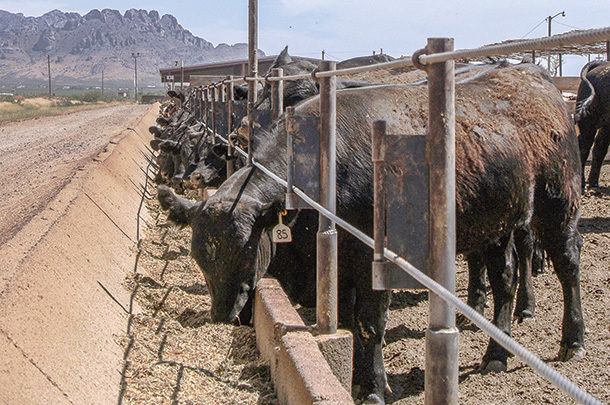Cattle producers are invested in creating a quality product. Carcass grades, such as Prime or Choice, and high-yield grades have become attainable targets for producers to reach with good genetics, management, proper nutrition and health protocols.
The nutrition and health component of this equation carries quite a bit of weight. Adequate nutrition allows for beef cattle to continue to grow and add muscle and fat onto a sturdy frame. Maintaining the health of an animal allows that process to be as efficient as possible without disease or parasites interfering with an animal’s normal average daily gain (ADG).
Grain overload
A hefty part of keeping an animal healthy is providing adequate nutrition. Having previously worked in multiple veterinary clinics, I learned the value of proper feeding protocols and what can happen if they are not followed correctly. Feeding protocols and rations can become more complex when backgrounding young cattle or in a feedlot setting.
Particularly in these two stages of production, you want to maximize nutrition while still maintaining the animal’s health. In a feedlot or when providing grain to older calves being backgrounded, liver abscesses are something that can be a concern. Liver abscesses are primarily caused by bacteria which typically originate from a bout of ruminal acidosis. Ruminal acidosis can be caused when a large volume of easily digestible carbohydrates are ingested into the rumen during a short period of time.
This is commonly referred to as “grain overload.” This is easy to do when younger animals are entering a feedlot for the first time or when a ration is drastically changed for a group of cattle. The rumen contains good bacteria and other microorganisms (microbiome) which break down the grains and forages that are eaten.
Road to abscess
These “rumen bugs,” as they are sometimes referred to, don’t do well with drastic changes. A grain overload situation will cause the rumen microbiome to rapidly digest these grains, producing a much more acidic environment and damaging the rumen. The increase in acid can cause ruminal ulcers, allowing undesirable bacteria and endotoxins to enter the bloodstream and be transported to the liver.
As the blood is then filtered by the liver, the undesirable bacteria then grow and create a liver abscess. Affected livers usually have around 10 abscesses, which are typically 1.5 to 2 inches in diameter, but can have up to 100 abscesses. The Merck veterinary manual states that these liver abscesses can cause poor growth efficiency and a 5% to 15% reduction in gain compared to cattle without abscessed/scarred livers. These livers can also be condemned at slaughter and, if severe enough, could cause price docks on carcass value.
A study done by the Beef Quality Assurance (BQA) program in 2016 saw a nearly 10% increase in the number of livers being condemned as opposed to a study done in 2011 by the same program. Slowly increasing the amount of grain in a ration for new feedlot animals and taking care that no drastic changes are made to a ration or normal feeding schedule will aid in avoiding that overly acidic rumen environment.
Notating your vaccinations
In regard to animal health, it should be noted that more emphasis is being placed on food safety than ever before. Types of medication and when they are given should be noted on every producer’s animal health records. This is important, since every drug label will have instructions on how the medications should be given and if there are any restrictions or withdrawal periods for an indicated drug. Ensuring these restrictions/withdrawal periods are followed allows for that carcass and the resulting retail cuts to be safe for the consumer.
A study published in 2011 by the BQA program revealed that less than 50% of producers interviewed actually had written records to track withdrawal times within their herds. With the abundance of technology available to producers today, record-keeping need not be a cumbersome task. An app on the phone in your pocket or a tablet, iPad or computer kept in the truck are easy and efficient ways to maintain herd health records.
An effective vaccination protocol is a must in good ongoing ranch management and cattle health. The old saying, “An ounce of prevention is worth a pound of cure” maintains merit in the cattle industry. In most cases, the cost of a dose of vaccine is much cheaper than a dose of medication to treat an illness. Vaccinations should be a part of each life stage of a beef animal. From the time that calf is born to the stocker and feedlot stages, vaccinations can help that animal’s immune system ward off illnesses that can affect their performance or even kill them.
One example would be vaccinating against bovine respiratory disease (BRD). BRD is a top cause of morbidity and mortality in finishing animals, costing the beef industry millions of dollars each year. BRD can cause lung adhesions, lower carcass weights and lower marbling/yield scores. A yearly vaccination can eliminate this economic loss. Also, consider preconditioning your calves after weaning and prior to shipping to a feedlot or other ranch. These seemingly small steps are opportunities which will aid in maintaining good health in your herd, which in turn will allow these cattle to efficiently create a robust carcass.
Avoiding lesion effects
Vaccinations must be done properly, though. Over the past decade or so, there has been a continual push to increase awareness of the damage injections (vaccinations or medications) can cause to a carcass. This is why all cattle injections should be placed in the neck, which is not a portion of the carcass which brings the most money.
These “money cuts” are in other primal areas of the animal, such as the chuck, rib, loin and round. Poorly placed injections can cause lesions, scar tissue and/or discoloration to form at the injection site, due to the natural reaction of the body to the drug being injected. These blemishes necessitate meat processors to either trim these areas off a primal or, if very severe, condemn it altogether.
Studies in 2016 and 2017 looked at the number of muscle lesions in the round of selected carcasses and found that about 7% of beef carcasses and 15% of dairy carcasses contained injection site lesions. A majority of these were identified as older lesions and were mostly congregated in the outside of the round (biceps femoris muscle) rather than the back of the round (semitendinosus muscle) in both beef and dairy carcasses. These numbers have greatly improved over the past decade but still need continual refinement.
Poor needle selection can also be a cause of scar tissue. When overly large needles (larger than 16- or 14-gauge) are used, undue trauma can occur to that area. Dull needles will have the same effect, since more pressure is needed to push through the thick hide of that steer you are trying to vaccinate than a sharp needle will. A sharp needle will cleanly puncture a hide, while a dull needle will tear at the hide.
With all the noise, commotion and four-letter words that tend to slip out when cows are not moving ahead like they should, it’s easy to forget to replace your needle as often as you should. Needles should be replaced every 10 to 15 cows to maximize the effectiveness of the needle and minimize tissue damage. Next time you are designated to handle the vaccination syringe, take note of the increased pressure it takes to push the needle in on that eighth cow than the second cow.
Maintaining good health through good nutritional management, vaccinations and proper injection protocols in your herds will support the animals to be efficient in developing a high-quality product for our consumers. Help us maintain the quality and integrity of the beef industry and keep your animals healthy.
References have been omitted from the article but are available upon request directly to the author.









